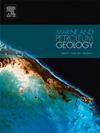Shallow gas accumulation mechanism in the Qiongdongnan Basin, South China Sea
IF 3.7
2区 地球科学
Q1 GEOSCIENCES, MULTIDISCIPLINARY
引用次数: 0
Abstract
The Qiongdongnan Basin is one of the most important oil and gas basins in the South China Sea. Previous studies primarily focused on the middle strata around 3000–4000 m. In recent years, abundant shallow oil and gas resources have been discovered in the shallow Ledong Formation of the Qiongdongnan Basin. Previous researchers believed that these shallow accumulations originated from deep strata and that the shallow strata could not serve as effective source rocks. There was a lack of relevant studies on how deep gas sources transport gas to shallow areas, where gas was accumulated in shallow layers, how the cap rock was distributed, and how the transport system, reservoir, and cap rock matched. This research aimed to clarify the types and spatial distribution of transport systems in the study area using 3D seismic data, combined with methods such as root mean square amplitude attributes and variance cube slicing. Simultaneously, it sought to identify the development types and sizes of reservoirs and cap rocks and elucidated the relationships among these three influencing factors, clarifying the process of deep natural gas accumulation in shallow reservoirs. Six transport systems, including diapiric gas chimneys, fracture-type gas chimneys, polygonal faults and fractures, large faults, submarine slump, and multi-stage channels, were identified in this study, along with their distributions. The main reservoirs in the Ledong Formation were submarine fans, slope fans, and shoreland sandbars, with their upper portions predominantly capped by mass transport deposits and mudstone layers. Based on these findings, the spatial matching of transport systems and reservoirs was conducted to clarify the process of gas migration, transport, and accumulation from deep to shallow strata, summarizing corresponding accumulation models. Gas chimneys and faults were considered the primary transport systems, while submarine fans were identified as the highest-quality reservoirs, and mass transport deposits were effective cap rocks. The accumulation model formed by the combination of these three elements represented the primary accumulation mode in the study area. The results of this study will provide guidance for the development of shallow resources in the South China Sea.
求助全文
约1分钟内获得全文
求助全文
来源期刊

Marine and Petroleum Geology
地学-地球科学综合
CiteScore
8.80
自引率
14.30%
发文量
475
审稿时长
63 days
期刊介绍:
Marine and Petroleum Geology is the pre-eminent international forum for the exchange of multidisciplinary concepts, interpretations and techniques for all concerned with marine and petroleum geology in industry, government and academia. Rapid bimonthly publication allows early communications of papers or short communications to the geoscience community.
Marine and Petroleum Geology is essential reading for geologists, geophysicists and explorationists in industry, government and academia working in the following areas: marine geology; basin analysis and evaluation; organic geochemistry; reserve/resource estimation; seismic stratigraphy; thermal models of basic evolution; sedimentary geology; continental margins; geophysical interpretation; structural geology/tectonics; formation evaluation techniques; well logging.
 求助内容:
求助内容: 应助结果提醒方式:
应助结果提醒方式:


